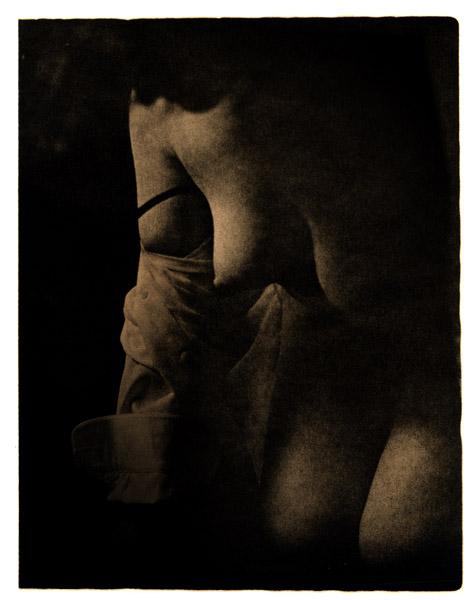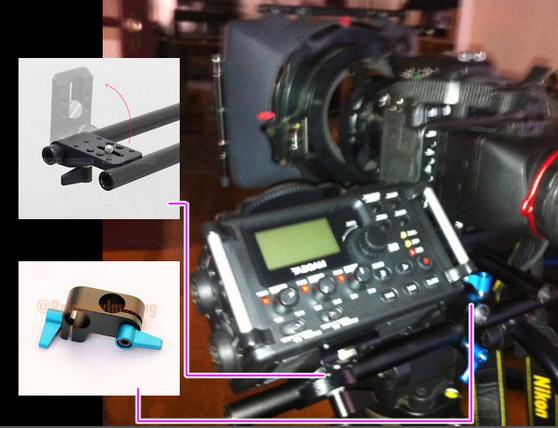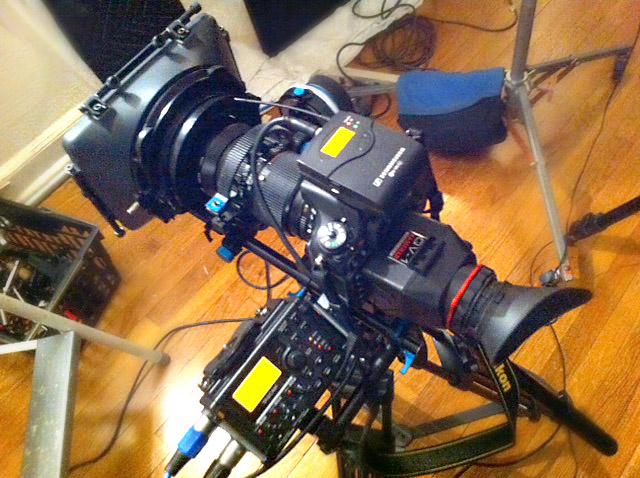-
Posts
388 -
Joined
-
Last visited
Content Type
Profiles
Forums
Articles
Everything posted by M Carter
-

Blackmagic URSA Mini - $2995 - official thread
M Carter replied to Andrew - EOSHD's topic in Cameras
I dug through the mini specs and never saw it powered with anything at all. Only that is has a power-in port and an available pinch plate for pro batteries. I'd be pretty amazed if you could power the thing with a DSLR battery. Or even two. -

Blackmagic URSA Mini - $2995 - official thread
M Carter replied to Andrew - EOSHD's topic in Cameras
Do you mean the new 5" monitor/recorder? The specs say it will work with record triggers, though it doesn't give any listing or details. I'd assume the Atomos list might be the same when this gets sussed out. -
Why would you want an ENG camera with interchangeable lenses? The idea is to get out there and shoot, not say "oh, this fire would look better with my wide lens instead of my normal - please don't do anything cool for a couple minutes, firemen..." I get the very strong feeling that people ragging on this camera have never done a real run/gun shoot of a fast moving & unscripted event, where they have to run between indoors and outdoors, get all the shots from sunrise to dusk, be grabbed for quick interviews in the middle of it all, etc. Like I said earlier, some quarters that's 70-80% of my income. Yeah, I wish I could pay 100% of my mortgage with awesome music videos, but it beats sitting in a cubicle. The Ursa Mini for ENG/run & gun? Sure, if it has ND, focus, iris and zoom that can be controlled from shoulder mount handle (or crane back), very good stabilization, multiple gain levels via switch, 1-press manual white balance, a great EVF with useable peaking, affordable media, long-lasting battery, and a very wide zoom range, light enough to live on the shoulder all day if needed. That's what (at least) I need for event shooting (hell, I don't even need AF or any auto functions). Realistically, you're talking two different cameras for two very different uses.
-
I'm presently agonizing over, say, and NX1 or really biting the bullet (artillery shell?) and getting something like the Ursa mini. For my work that I need to look beautiful. But y'know what? 70% of my video income the last year has been with an AC-130. Not sure why, one big corporate client likes me to shoot their community events and whatnot. I grabbed that camera the week before a shoot out of the US, loved it and still use it weekly. Sometimes the local news is out there (smaller markets, big master planned communites out in the country - but $1m homes) with their DSLRs and AF-100's. And when things are moving fast, they miss about half the shots when I get 'em all. All I've wanted as an upgrade for that kind of work is a 4K 24p camera, that can at least do 1080@60p, with decent low light and that will take my existing focus and zoom controls. Looks like I got it. There's a market for this camera. At $5k, I dunno - under $4k, yeah. Sure, I guess we could use a another swappable-lens "cinema" camera with 4K. Throw in remote focus, iris and zoom, built-in ND, XLRs, etc, a good VF and affordable media and I could see it replacing this form factor for me - I would love love LOVE to have one system for everything I do. But often that means it doesn't do everything well. This new camera is great for a scenario that has a lot of billable hours. It's an evolution of a product that's worked well, from the DVX to the HMC to the AC line. I'm pretty psyched.
-
I remember (very happily) viewing, trimming and batching all my DSLR footage to prores after a day's shooting in MPEG Streamclip. It's still such a useful little freebie and I probably use it at least once a day. I'd just be happy to have that capacity for H265 - view, trim, batch transcode to ProRes without image change, 4K or 1080. I can find plenty of stuff to do while it chugs away. Much rather have native H265 in After Effects, to tell you the truth... but the above prores files would be just fine for effects work, too.
-
Getting involved in a film vs. digital argument is a waste of time. They're both good for specific needs. A year ago I built a wet darkroom. It's freaking magic in there. Photoshop and AE are pretty magical as well. Film is far from dead - Ilford stuck with it with their fingers crossed - they've been seeing sales growth and predict a healthy (though smaller than the past) market. A good friend on mine said "it's like Vinyl vs. MP3 - and Vinyls' suddenly cool again..."
-

Noob question: Rokinon/Samyang Cine lens focus ring teeth - universal ?
M Carter replied to anchoricex's topic in Cameras
The RockSam teeth should mate with any "cinema" style FF. The size (actually the gear pitch) isn't 100% standard - some ENG lenses are different - but in general terms, an FF made for DSLRs/etc will mate with the Rockinon, and with all the aftermarket lens gears from Redrock, eBay, etc. Some FF's sell various gear pitch drive gears for other lenses. Here's a link: http://www.zacuto.com/follow-focus-puller Also, a killer deal on an FF is the "Fotga DPII" - they're on amazon, mine was $170 or so, and you can buy spare gears and locking pins as well. Pretty shockingly good for the $$, I'm sure others will chime in with their picks. -
Can't speak for the zoom. The DR60D can be odd with AA rechargeable batteries - I think if you have one that's starting to get weak, the 60D detects it and starts throwing warnings. Seems picky about rechargeables. But with a USB battery (the kind to make your phone run longer, by Anker, etc, $20-$30 - it'll run about 24 hours. So that's all I use now). The 60D has phantom power and will "handle" any professional mic signal. I feel the meters are too conservative - you would want to do some tests, record some test audio and look at the waveforms in an editor - it doesn't have tons of gain to spare but is fine for anyone that knows gain staging and mic placement. I find the limiter and low-cut to be very well done and I just leave 'em on now. I shot an Emmylou Harris solo show and used it for the board feed, I turned off the limiter and low-cut for that. Final mix really came out nice.
-
This thread doesn't address one of the greatest issues of choice vs. creativity - which is partnership vs. control. For the last year or so, I work work work with macs and digital... but my creative work, my play? Film, 60's era metal cameras, an enlarger and lith developer. Every step of that process means working within the confines of the medium. Particularly lith printing, which is very hard to replicate across 2 prints, and is packed with "ghost-in-the-machine" oddities based on chemistry and temperature and the fact that every print you make changes the chemical composition of the developer. You simply can't "control" any step of the process with any sort of totality, from exposure to final print, like you can with a digital camera and Photoshop. But once you decide you are a "partner" with the media, the game changes. Why do we make partnerships? Usually to add unique strengths which we don't possess or aren't remarkable at, to our creative, business, romantic, or fun pursuits. When you allow chance and surprise into the process, its like being handed a very active and very able muse. I shot about 200 frames, digital, of a nude for a friend who wanted to get a sense of "how she looked" in that scenario. I shot 3 or 4 frames with an old Minolta rangefinder, and one of those just had lots of the mojo I want from a shot. Printing it was work - to get those tools to sculpt the print into what I wanted, while making room for the oddities of the process and making them work together. It's probably my favorite bit of creative output this year. And those things inform my "controlled" work as well.
-
Works fine for me and is very useful. I have the original, not the MKII - you really need to do some tests with the unit - my meters are very conservative, and if I set levels at what seems proper, I have pretty weak tracks. The self-noise of the 60D is fine, but I'd really like a beefy waveform. Set it to really hit the peaks and use the minus-6 backups. The limiter is very natural sounding - I use it all the time. It's not a total brickwall, but it helps. One of those Anker USB phone batteries will power the DR-60 for hours or days. The the 60D is very picky about internal batteries and will report "dead battery" for batteries with a lot of juice left, esp. with rechargeables. Any USB power source (like a little phone charging brick) will power it via USB if necessary when you're in the studio. One final tip - just do the quick format for cards - the full format, myself and many people give up after ten minutes or so and disconnect power.
-
That's my "there's time to get it right" without a rental setup, vs run & gun camera... Nikon D7100, Fotga follow focus, a loupe, matte box, and (somewhere off frame) a monitor with peaking and 1:1. Probably an 85 1.8 on the camera, this was a corporate interview and that lens... if I had panties they'd be soaked! I just use rubber hoods pressed against the matte box instead of donuts, that's very quick and easy and I can leave them on the glass. Well, just scrolled up, not sure what lens that is, could be a nikkor 35-70 2.8? Sold that a while ago for a 28-70. It's a great little setup and was pretty cheap - that Fotga FF is really a super buy.
-
I use a 15mm rod fitting I found on ebay on the bottom of the DR, and a 90-degree fitting on a piece of 15mm rod. The rod is fastened at 90 degrees on the left rod in the pic, and the right rod keeps it from twisting (the weight of the DR would make it drop, but the rod under the DR hits the right rod so it's stable, if that makes sense!). Can't remember the link for that little part, it was like 9 bucks from China. If you go into eBay photo and search "15mm rod" you'll get about 400 little doodads, some of which are pretty useful. By the way, now I use a little Anker USB battery - I had an old Sennheiser G3 receiver shoe mount, I just velcro the Anker to that and it lives on top of the DR via the DR's male screw.
-
I've wondered myself - if the screw mount on the 70d is the same hardware as the 60d, that thing is pretty big! My only issue with the 60D? When the meter says it's peaking, it's not even close. I've gotten a lot of audio tracks that are pretty weak until I learned to (A) kinda slam the meters, (B) activate the -6DB safety track for peace of mind and (C) use the limiter (See"B")! Also, it has some issues with rechargeable batteries, announcing they're too low of a charge. But the 60D will run ALL FREAKING DAY with something like an Anker USB battery - $30!! I mount mine on a crossbar of 15mm rod, works great for tripod work...
-
That would be interesting - you look at the specs for NX1 Af and it really is next-generation. AF that could track without jitters would be pretty amazing.
-
I'd just looove to see a video test where that actually works for motion. Hey, maybe Samsung will surprise me, but I think you'll start really missing a focus puller with an FF when you try it...
-
I can't imagine getting really pristine sound from any DSLR - so-so circuitry designed to be tiny, not awesome. It's not about camera gain settings or XLR adapters. Don't choose a camera based on its audio capabilities, choose it as a camera. A Tascam DR-60 is 10x the utility and quality, and comes with PluralEyes, so your synch issues are history. 2 tracks with phantom power (and a -6DB backup track of each for safety) and 2 more line ins, headphone out with a level KNOB and line out - with a knob as well. A really, really unobtrusive limiter and a low cut. Can't beat it for $200. And that's just the entry level, but you get XLR combo's, good meters, a wealth of features. I shoot plenty of corporate stuff all by myself. It really doesn't take me any remarkable amount of time to plug my mics into a recorder vs. a camera. When I'm doing interview stuff or planned-out stuff with DSLR or BMC style cameras, I run a line out from the Tascam to the camera for cleaner synch. But PluralEyes synchs with the in-camera mic just fine. You can mount a recorder on your rails or stick it where it's convenient. If the gig is just a crazy run & gun deal, I use a "video" camera with ND, zoom, a real viewfinder with peaking, XLRs, etc. I've watched the DSLR guys miss 20% of their shots at those deals. Plugging mics into an NX1 (or a 5D or a Nikon or a BMC)... just don't do it. If you can afford a YHAGI you can afford a great recorder and do it right. $199 gets you out of the crap preamps realm, and if you have more budget you can get more. And the YHAGI is pretty overpriced unless you need the SDI. Dual system sound just does not add complexity to worry about. YMMV and my .02 of course...
-
Regarding the comments on animators... My son is in his last semester of film school at the University of Texas. For the last four years, he comes home, we have dinner, we laugh and talk, or go out for burgers and a beer (he's quiet until he has something truly funny to say and then it's devastating, not like me just throwing verbal spaghetti at the wall all day. He's the kind of child you don't even dare to wish for in the delivery room.) Then he goes to his room, plugs a stylus pad into his laptop, and begins drawing one frame at a time. For hours and hours and hours. He's developed his own methods that are kind of strange, but he's been singled out as one of the top students in this graduating film class. So Andrew's thoughts on animators are exactly what my kid is. He's a good looking, smart and funny guy - and when he's not grilling ribs with his room mates, he's alone in these worlds he creates, doing it his own way. I think he'll go far. I guess I just wanted to BRAG A LITTLE... but have a look at one of his shorts: http://www.dylcar.com/spider-bite/ Or if you have Flash installed, he actually got some international press after this piece was completed: http://www.dylcar.com/alz/
-
Having single AF can really be a godsend. I use it with Nikons on cranes or even steadicams. Not for the whole clip, but just to set initial focus point. With the D7100 on an 8' Kessler crane, I took a $9 Amazon wired shutter remote, spliced 1/8 stereo male & female jacks, and got a 6' mini headphone extension cable. With that and an HDMI viewfinder, I can get the crane's height and angle set, set the focus point, and trigger the shot. Of course, if focus needs to shift during the move I have to operate from the front, usually with a monitor on a stand or a an assistant holding a VF up to my eye (this can work surprisingly well, especially in bright sun). Samsung has released an SDK for camera control, so we should be seeing some stuff appear eventually in that dept.
-
So... $1100 for the D7200. (And I say this as a guy who loves the look from my 7100 - and I'm all-aperture-ring glass so I don't give a flip about LV aperture changes - even if I could, I'd still just use the ring) What about the 7200 would keep someone primarily doing motion work from buying an NX1? It's not glass investment - I can stick my Nikkors on an NX1. I'm not railing on Nikon - either (A) video buyers who want pro features are too small a market segment for them to worry much, or (B) they'll announce a 4K cinema camera in the next year. (If you chose "B", I'd love to try what you're smoking...)
-
The "old" lens isn't necessarily an issue... we're reaching a point where glass can only get so much sharper. The 28-70 is gorgeous. And yes, mine is primarily my main video lens, so if the AF conks out, I may not ever notice... the main issue with the 28-70 vs. the 24-70? The 28's a beast. One big-ass lens. But I kinda like that... does mean an extra 5 pounds on the back of the crane though!
-
Man, if we're down to AGC and auto-ISO as the last bugs to kill? I'm in. I've submitted a lot of invoices for projects with some or all DSLR footage - never once relied on in-camera audio for anything other than synch, and never relied on auto-anything. (But DSLR has never cut it for event shooting or run & gun for me... gimme a broadcast-style camera, I get out the DSLR for more planned methodical work). Really digging what Samsung is doing... seems like "LISTENING" is something they're into.
-
The 7200 is a shockingly ho-hum upgrade. For 7100 video users, all you get is full 1080 @ 60p. My next body will be an NX1, which will just love my Nikkor glass. I'm a little jaw-dropped by Nikon this week. They should have made their own cheapo cinema camera a year ago. Meanwhile, Samsung seems in this to win. As far as the 7100 - never missed an articulated screen on any DSLR, but I have a loupe, an HDMI viewfinder and an HDMI monitor. I think about every time I would have needed an articulated screen, a monitor would have been 500% better anyway (I'm in Texas - the sun gets pretty dang bright here...) In fact, I have never, ever, ever shot an important video clip with "just the camera screen" on any of my cameras. It's either a built in VF (on broadcast-style cameras) or a loupe or a monitor or an external (HDMI or SDI) VF. You just can't guarantee focus on a 3" screen - I even keep 2x reader glasses in all my camera bags (handy little helpers for focus!) but I still only use those on at least a 5" Marshall. (Cheap reading glasses are just kickass with monitors though! You can't focus on anything father than 6" or so, so they really keep your brain focused on the screen).
-
I've downloaded several clips. Start googling, they're out there.
-

Dog Schidt Optiks Flare Factory 58 (PL Mount) Review
M Carter replied to Andrew - EOSHD's topic in Cameras
As pleased as I was to see that there's another human being on earth into the Close Lobsters... imagine my dismay when you credited "The Close Lobster". Turns a great band names into something that just sounds silly. Or like one of them went solo. Pfft. -
I've shot tons of work projects with the 7100. I did rent a 5300 for a fast paced shoot and dedicated it to steadicam so I wouldn't have to be all on-off, rebalance, etc. Through grading, effects, and editing, I really didn't get any sense of difference between the two. Very similar looks and the full 1080 60p of the little 5300 was handy. Kinda hated the aperture issues (I rented a newer wide to go with it, and then dumped the rental lens for a wide Nikkor zoom with ring). All my glass has rings - even when I shot video on Canon, I hated changing apertures on the body and ended up just using Nikkors on the EOS. But having to kick out of live view to change apertures was maddening.





